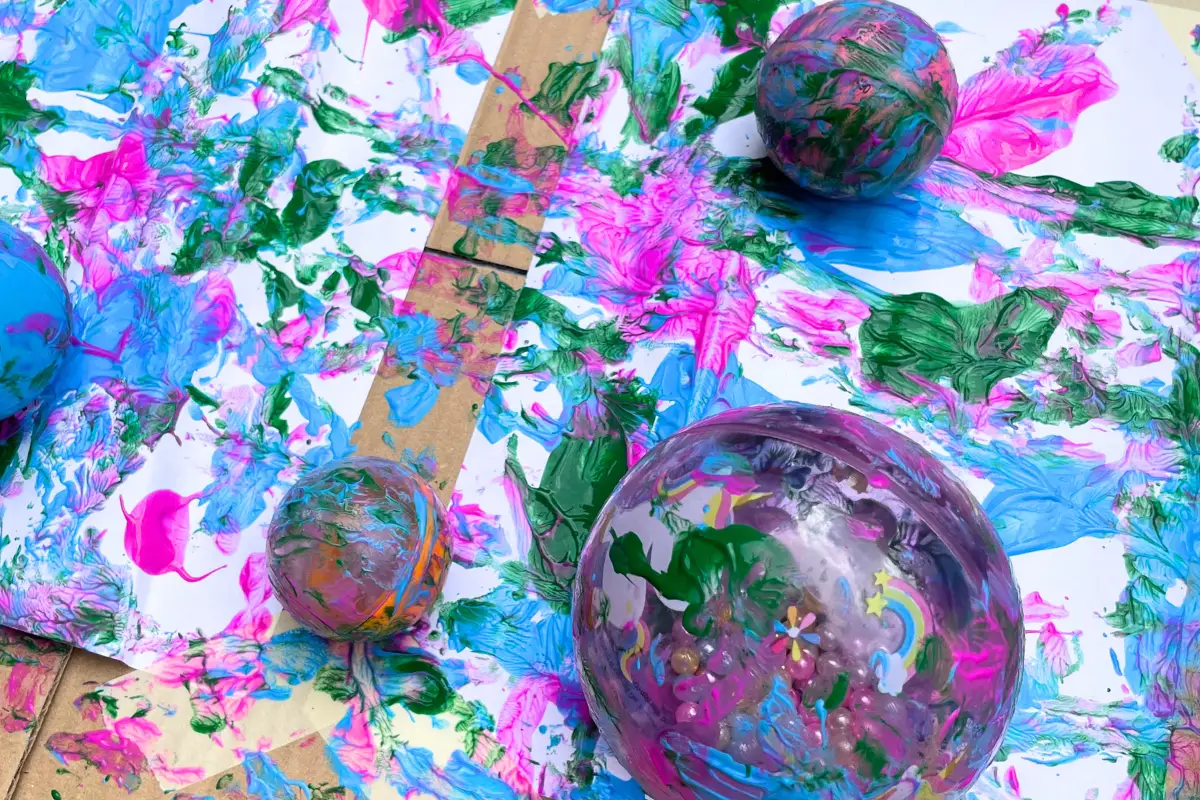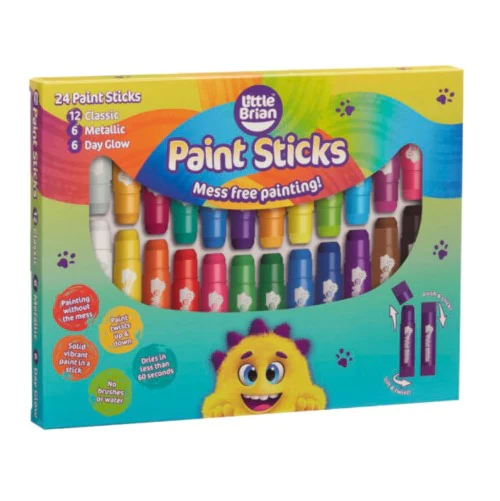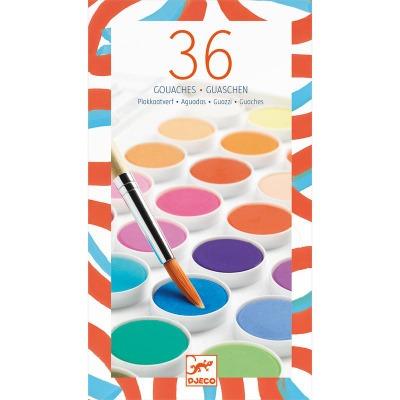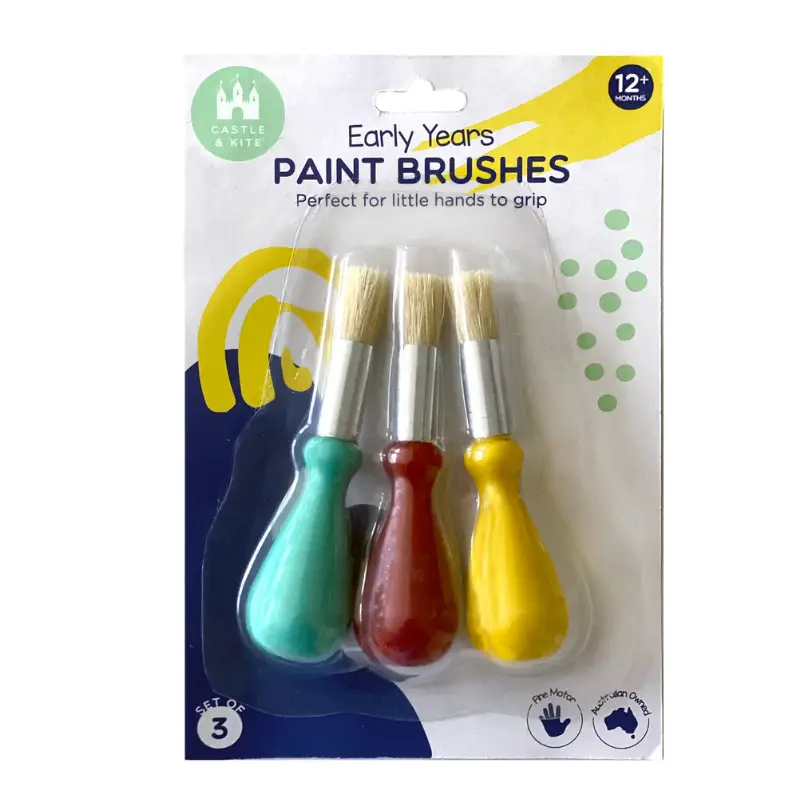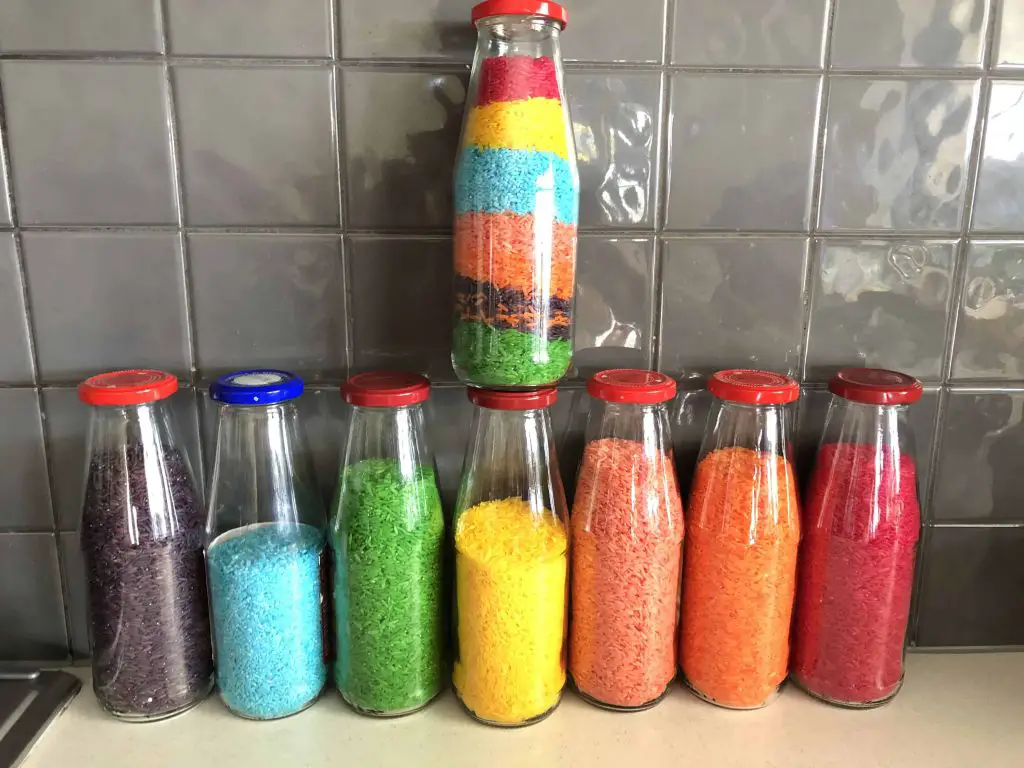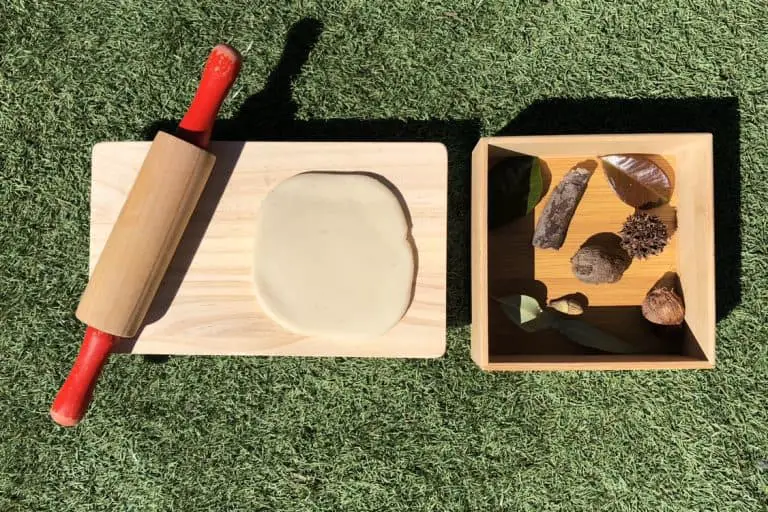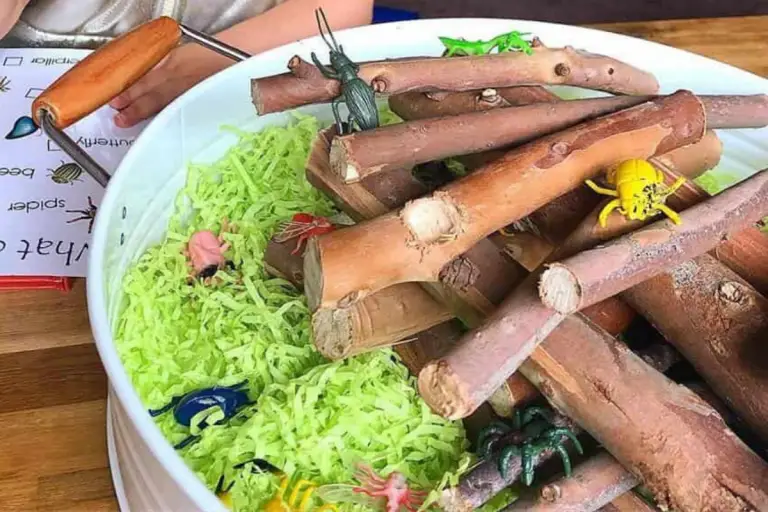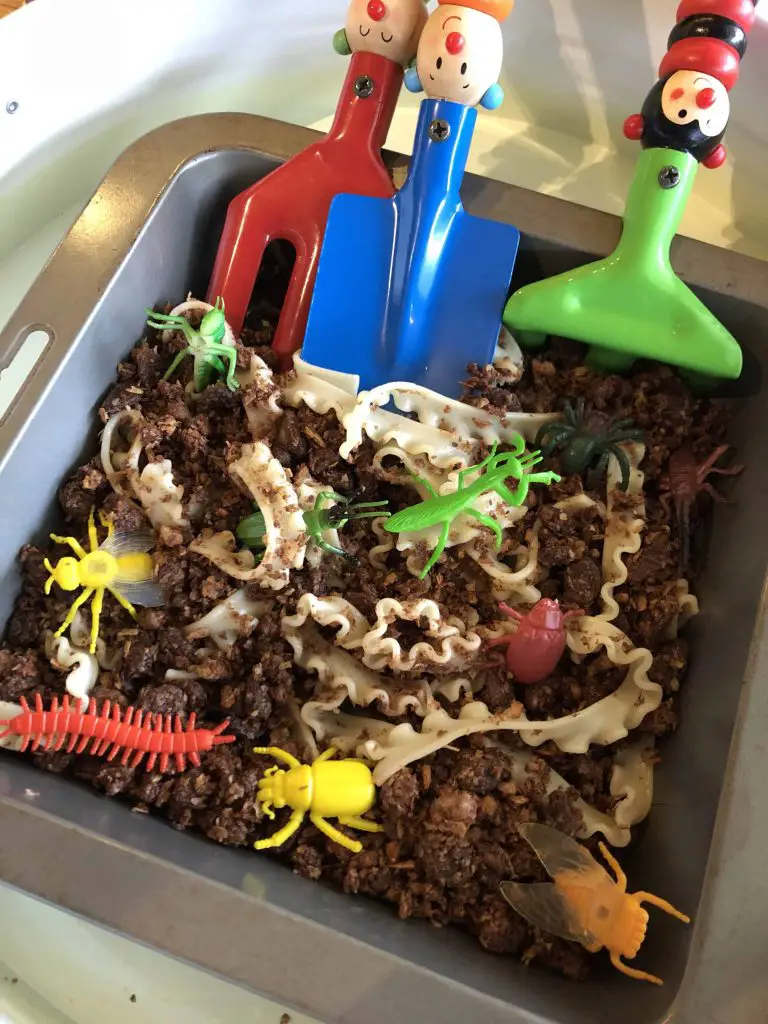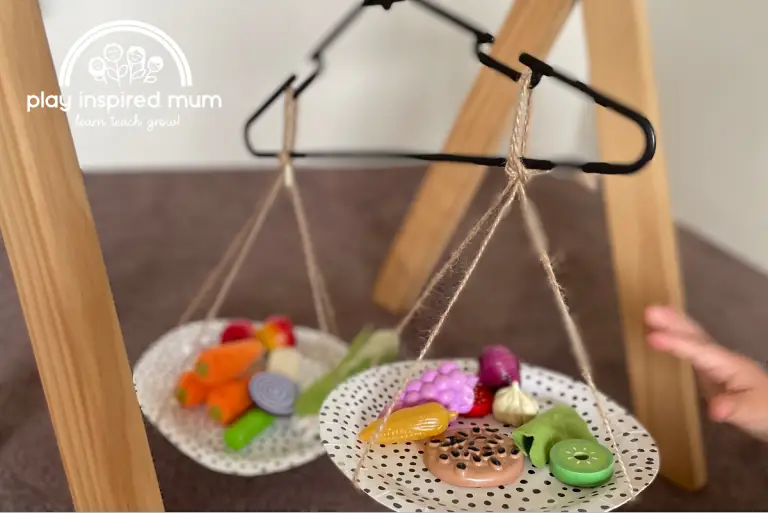Painting with Balls: Process Art and STEAM Activity
Disclosure: This blog contains affiliate links which I may earn a small commission from if you purchase through them, at no extra cost to you.
Get ready to explore the super cool realm of painting with balls with your toddler in this article.
Brace yourself for an artistic adventure where your toddler can experiment, explore, and create their very own masterpieces. That is while boosting their fine motor skills, cognitive abilities, and sensory experiences.
We’ve got a step-by-step guide that will make your toddler’s eyes light up. We’ll spill the beans on what materials you need, how to set everything up, and juicy tips to get your tiny Picasso experimenting and creating like never before.
We have some tips on what to do with all the art pages coming your way.
Then let’s uncover the fantastic benefits of process art for those imaginative tots. We’re talking about unleashing their creative side, honing their fine motor skills, and supercharging their brain development.
From there, we introduce the world of STEAM activities and discover why they’re so important for those curious little minds.
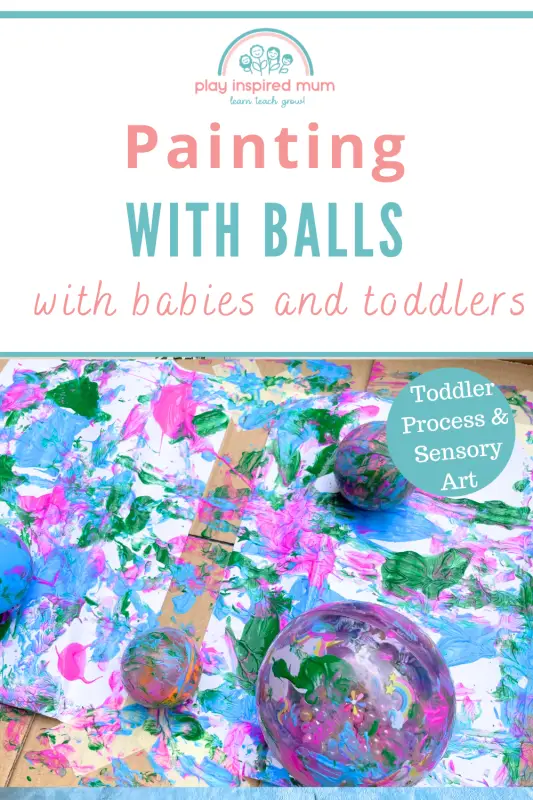
Painting with Balls: Process Art and STEAM Activity
Painting with balls isn’t just about having a blast.
It’s a sneaky way to learn some awesome STEAM stuff too.
We’ll reveal how these little artists can become mini-scientists by mixing colors and discovering cause and effect.
And get this, they’ll even get to experiment with cool engineering tricks while rolling those balls around.
Plus, we’ll explore the artsy side of self-expression and creativity and even add some math mojo by counting and sorting those bouncy little artists.
It’s all about nurturing their imagination, fueling their curiosity, and setting them up for a world of success in school and beyond.
So, buckle up and get ready to embark on an extraordinary adventure into the mesmerizing world of painting with balls!
It’s a place where imaginations soar, creativity knows no limits, and the joy of creation is simply irresistible.
What you need to set up painting with balls
- Paint
- Balls
- Paper or cardstock
- Tape
- Cardboard box or tray
- Waterproof playmat (optional but so handy for indoor play)
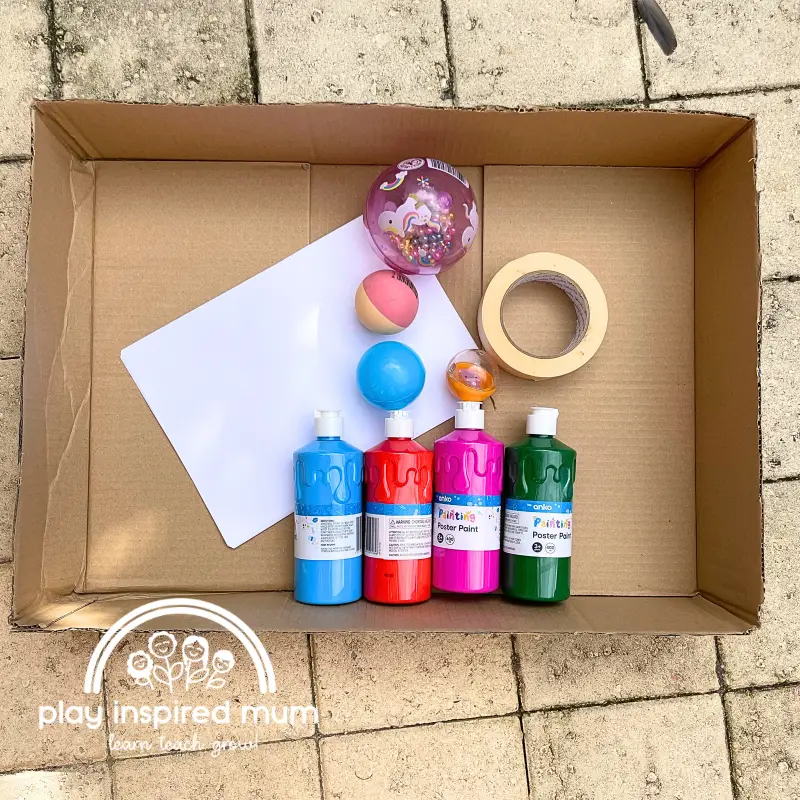
Paint
Choose non-toxic, washable paint in vibrant colours. Acrylic, poster, or tempera paints work well for this activity. Consider using a variety of colours to add more excitement to the artwork.
Watching primary colours create secondary colours is so rewarding for our toddlers – they love watching the new colours appear like magic.
Blue + Yellow = Green
Red + Yellow = Orange
Blue + Red = Purple
Balls
Select a variety of balls with different sizes, textures, weights, and bounciness.
Examples include:
- Rubber balls
- Foam balls
- Sensory spikey balls
- Tennis balls
- Plastic balls
- Ping pong balls
- Golf balls
- Marbles
Paper
This activity uses a generous amount of paint so it can get quite wet. Traditional printing paper may not hold up well to the high moisture and tears easily as it gets soggy. Thicker paper or cardstock will hold its form better when wet. Cereal boxes cardboard and canvas would make alternatives to paper too.
Tape
We used masking tape to secure the paper to the bottom of our cardboard box. Masking tape or painter’s tape peels off easily making it an easy choice for our painting with balls activity.
Cardboard Box or Tray
This needs to be large enough to hold the paper but small enough so that it is easy for your toddler to manage. We are going to be lifting and moving the box to make the balls roll.
A huge part of this activity is the satisfaction of watching the balls move across the page. If the box is too large or deep, your toddler will miss this part of the activity.
I trimmed the upper flaps of our box to improve visibility and reduce distractions from the task. Who wants to be spending their time moving flaps of cardboard when pretty colours are being made? Not I!
How to create a painting with balls activity
- Prepare your space
- Tape paper to the bottom of your box or tray
- Drop blobs of paint onto the page
- Add balls
- Roll, experiment and have fun creating and learning while painting with balls
- Lay the paintings flat to dry
How do you paint with balls?
Painting with balls is lots of fun.
This relatively mess free painting activity is a fun activity for toddlers.
Given the paint is mainly kept in a box, it is a creative way of using paints with minimal risk for painted fingers across the house.
‘Cos us parents all have that fear niggling in the back of our mind when the paint pots come out.
Step 1: Preparing the space
While one of the perks of this activity is that it is mainly mess free, we are mixing toddlers with paint.
Accidents happen so it is best to be prepared.
If you are painting indoors, protect your floor with a waterproof play mat or shower curtin.
We took this activity outside where the paving could be hosed off in the event of a spill.
Step 2: Tape paper to the bottom of the box
This activity uses a lot of movement. The balls are going to be rolling across the page as the box tilts this way and that. Securing the paper to the bottom of the box ensures that it stays put with all the activity.
We used painters tape to secure our page. Painters tape is easy to work with. It peels off so easily.
I secured our page to the bottom of the box using a small strip of painters tape across each corner of the page. Our box was quite large so I taped two pages to paint at once.
Our goal was to make some homemade gift wrapping paper with our paintings. Doing two paintings at once saved time.
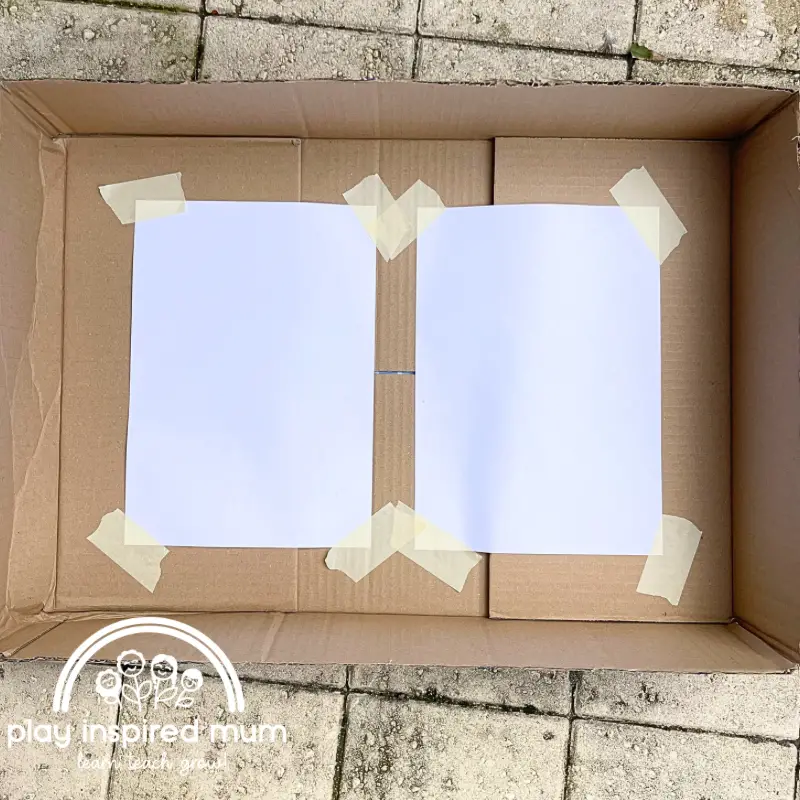
Step 3: Add drops of paint
Even us grown ups can get excited when dropping blobs of paint onto a page.
You need to be quite generous with your paint in this step. We used three different colours of paint at a time. There are no real right or wrongs to how close to space the blobs or anything. I left plenty of white space between our to create more room for ball tracks.
Step 4: Add balls
Before adding the balls to the box, we compared the balls against each other.
We compared texture, size and weight of the balls and made predications of how the the balls would behave because of these differences.
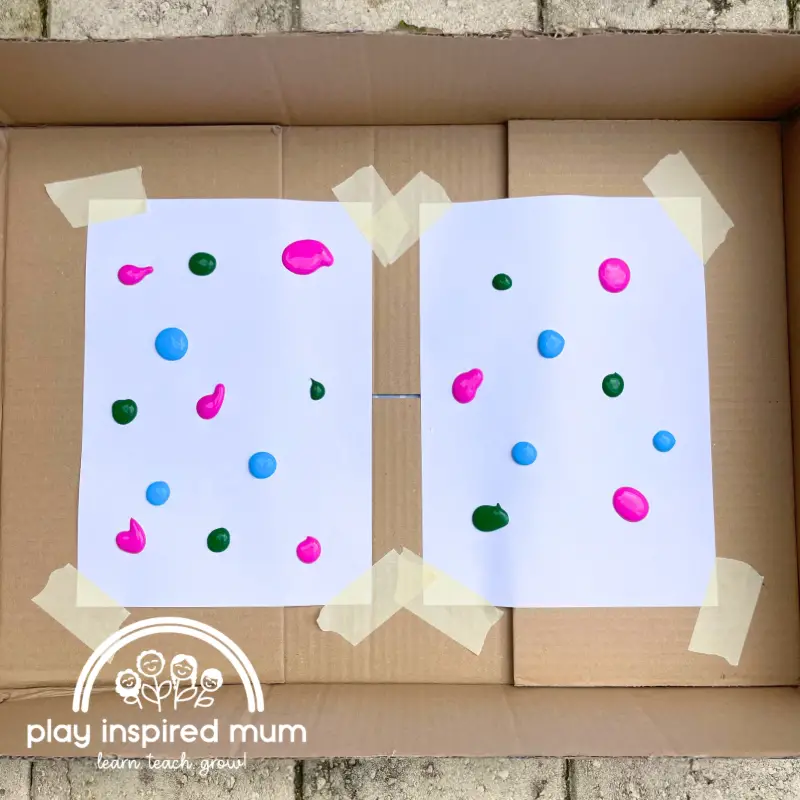
Step 5: Roll, experiment and have fun
And so the fun begins!
To get the balls rolling (pun intended), I modelled how to get some movement of the balls within the box by lifting and twisting the box with two hands.
Mr 2 watched attentively and did not hesitate to have a try himself. He loved watching the balls rolling across the bottom of the box. Once he got he got the nack of getting some momentum, I gave him the challenge of aiming for certain thicker spots of paint or filling larger white spaces.
He experimented lifting the box this way and that to make the balls roll in the direction he wanted.
We noted that some balls moved faster than others and explored different reasons why. He created his own little experiments to make some balls roll moreso than others too.
Once we were satisfied with the paintings, we peeled the tape from the bottom of the box and laid the pages flat to dry.
We then taped more paper down, added more paint and kept rolling!
Step 6: Drying your paintings
To protect our designs, we laid our paintings our flat across some cardboard to dry.
The paper was delicate due to the dampness from the paint. That being said, given it was a cooler winters afternoon, the paint dried quite quickly.
We finished them off with a hair dryer prior to using our paintings as gift wrap.
Benefits of painting with different balls
Different balls give different effects.
Heavier balls roll faster.
Lighter balls almost stick in the paint and can withhold a higher lift of the box before moving.
Textured balls leave different tracks streamed across the paper.
They make different sounds as they hit the sides of the box.
Larger balls leave a higher void line across the bas of the box.
Smaller balls have a shorter void line.
Using a range of different balls gives an opportunity for your child to explore the varibles, make predications and then test out their theories.
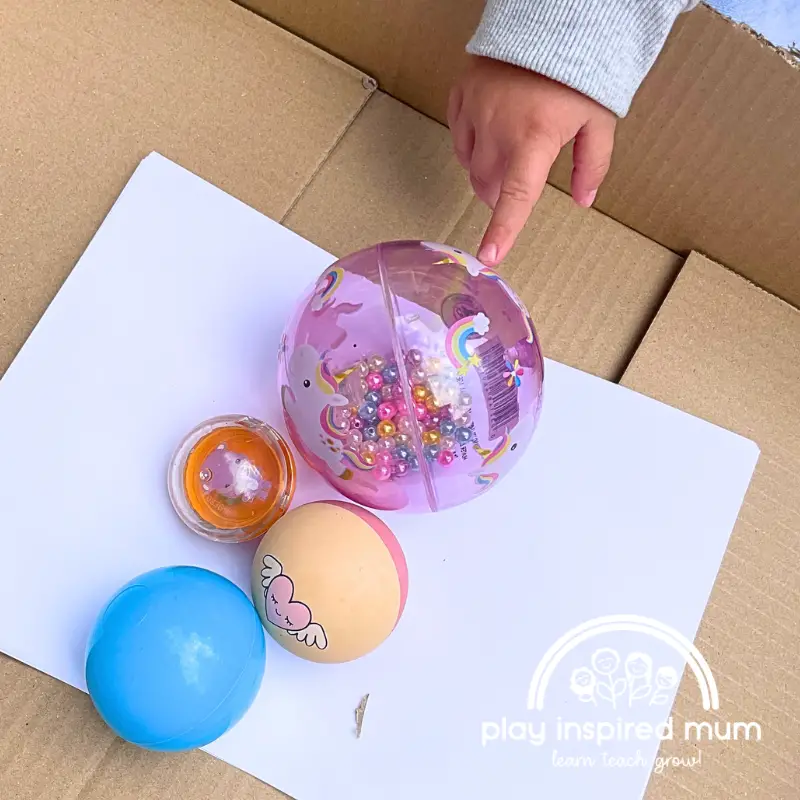
What are the benefits of ball painting with babies?
Painting with balls offers several wonderful benefits for babies.
While this activity is primarily designed for toddlers, babies can also benefit from participating.
Here are some of the benefits of painting with balls for babies:
Sensory Stimulation
Painting with balls provides babies with a multi-sensory experience.
They can explore the different textures, shapes, and sizes of the balls, as well as the sensations of rolling and bouncing them through the paint.
This sensory stimulation helps babies develop their tactile and proprioceptive senses, fostering their understanding of the world around them.
Fine Motor Skills Development
By grasping and manipulating the balls, babies enhance their fine motor skills.
As they try to control the movement of the balls while painting, this activity encourages the development of
- hand-eye coordination
- finger dexterity
- grip strength
Cognitive Development
Painting with balls engages babies’ cognitive abilities as they observe cause-and-effect relationships.
They can learn that rolling the balls in different directions creates unique patterns and marks on the painting surface.
This process allows babies to make connections and develop an understanding of how their actions produce specific outcomes.
Visual Stimulation
Babies are naturally drawn to bright colours and visual stimuli.
Painting with balls exposes them to a vibrant palette of colors and patterns.
As they observe the colourful trails left by the rolling balls, their visual perception and tracking skills are stimulated, promoting their visual development.
Creativity and Self-Expression
Even at a young age, babies have a natural inclination for self-expression.
Painting with balls allows them to explore their creative instincts by manipulating the balls and observing the patterns they create.
This process fosters a sense of autonomy, imagination, and self-confidence as they actively participate in the creation of their artwork.
Emotional Expression and Well-Being
Engaging in art activities like painting with balls provides babies with an outlet for emotional expression.
They can freely explore their emotions, release energy, and experience a sense of joy and accomplishment through their creative endeavors.
This can contribute to their overall emotional well-being and positive self-image.
Bonding and Social Interaction
Painting with balls can be a delightful bonding experience between babies and their parents or caregivers.
The shared activity promotes positive social interaction, communication, and connection.
It creates opportunities for babies to learn from adult modeling and strengthens the emotional bond between them.
It’s important to note that when involving babies in painting with balls, close parental supervision is crucial to ensure their safety.
The materials used should be non-toxic and age-appropriate.
Additionally, the duration of the activity should be adjusted to match the baby’s attention span and level of engagement.
Painting with balls offers babies a range of developmental benefits. From sensory exploration to creativity and cognitive growth, painting with balls is much more than just creating art.
It’s a fantastic way to engage babies in a fun and stimulating activity that encourages their holistic development.
Favouite Painting Tools for Toddlers
How does painting help in child development?
Painting with your toddler aids in so many areas of development.
Creativity
Painting sets their imagination on fire! Kids can go wild exploring ideas, playing with colours and shapes, and channeling their inner Picasso. It’s their chance to bring their craziest thoughts to life and let their creativity soar!
Freedom
Painting gives toddlers the freedom to explore and experiment with colours, textures, and materials.
They can mix colors, make bold strokes, and create their own unique masterpieces without any rules or restrictions. This freedom allows their creativity to flourish.
Communication
Painting provides a non-verbal outlet for toddlers to express their thoughts, emotions, and experiences. They can use colours, shapes, and brushstrokes to communicate and share their world with others. It’s like a visual language that allows them to tell their own stories when they are still developing a vocabulary, not yet able to find the words to communicate verbally.
Toddlers can let their imaginations run wild and explore endless possibilities. They can paint anything they can dream of, from imaginary creatures to abstract patterns. This open-endedness sparks their creativity and encourages them to think outside the box. There are no right or wrong answers.
Problem-Solving
Painting presents toddlers with creative challenges and opportunities to develop problem solving skills. They need to make choices about colours, tools, and techniques to achieve the desired results. This process of problem-solving boosts their critical thinking skills and encourages them to come up with innovative solutions.
Multi-Sensory
Painting engages multiple senses, such as touch, sight, and even smell. Toddlers can explore different textures, experiment with mixing colours, and experience the sensory pleasure of spreading paint on paper. This sensory stimulation enhances their creative experiences and deepens their connection with the art-making process.
Imaginative Play
Toddlers often use painting as a way to engage in imaginative play. They might pretend to be a famous artist, a fearless explorer, or magical creature while creating their artwork. This imaginative play fuels their creativity and encourages them to think imaginatively in other aspects of their lives as well.
Confidence
When toddlers see their paintings come to life, it boosts their confidence and self-esteem. They feel a sense of pride and accomplishment in their creations, which motivates them to explore and express their creativity further. This confidence extends beyond painting and positively impacts their overall sense of self.
Safe Risk Taking
Painting encourages toddlers to take risks and try new things. They can experiment with different techniques, mix colours, and make bold artistic choices. By embracing these risks, they learn that it’s okay to make mistakes and that creativity thrives when they step outside their comfort zones and demonstrate flexible thinking.
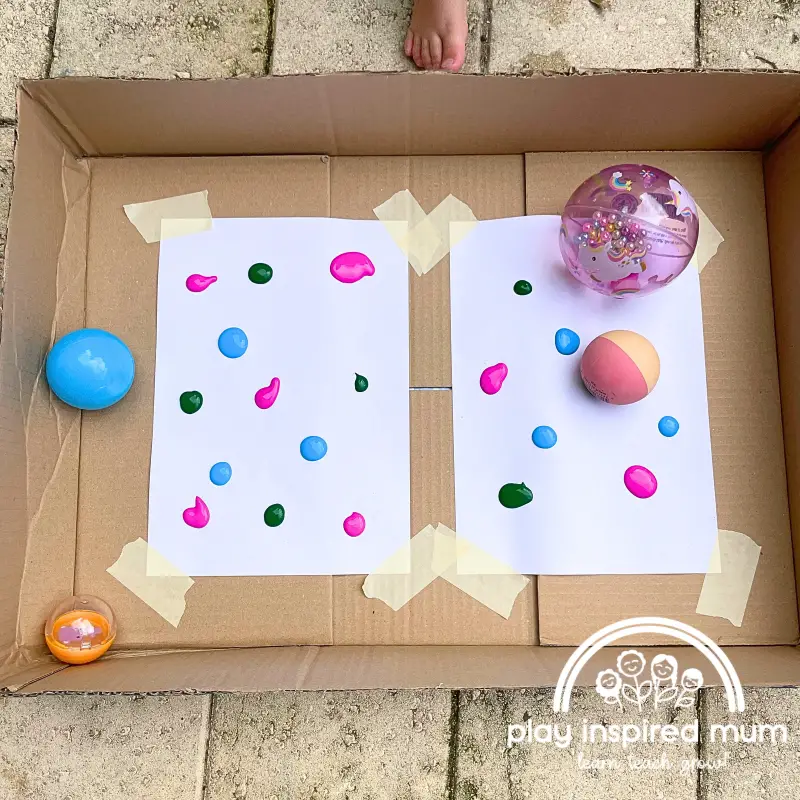
Motor Skill Development
Toddler painting is not just a creative adventure; it’s also a motor skill marvel! Here’s how it encourages the development of those important motor skills:
Fine Motor Skills
Painting with brushes or using their fingers helps toddlers develop and refine their fine motor skills.
Holding a brush, dipping it in paint, and making deliberate strokes on paper or canvas require precise control of hand movements and coordination between the eyes and hands.
These actions strengthen the muscles in their fingers, hands, and wrists, which are essential for activities like writing, drawing, and manipulating objects.
Hand-Eye Coordination
Painting requires the coordination of hand movements with visual perception.
Toddlers need to observe their own hand movements and adjust them to create the desired effects on the paper.
This practice enhances hand-eye coordination, which is crucial for various everyday tasks, including sports, playing musical instruments, and many other activities that require precise control and coordination between the hands and the eyes.
In this instance, while painting with balls not only is your toddler tracking the ball, they are coordinating the box movement of the box. Whether it’s aiming for a thicker blob of paint or trying to fill in a space left unpainted, they can make predictions and strategise a plan to encourage the ball to roll in a certain pattern.
Bilateral Coordination
Painting engages both sides of the body, promoting bilateral coordination.
Toddlers use one hand to hold the brush or manipulate the painting tool while using the other hand to stabilize the paper or canvas.
This simultaneous use of both hands helps strengthen the connections between the left and right hemispheres of the brain, enhancing overall coordination and control.
Grip Strength
Holding brushes, squeezing paint tubes, or manipulating other painting tools helps toddlers develop grip strength.
As they grasp and manipulate these objects, they strengthen the muscles in their hands and fingers, improving their ability to control and manipulate objects with precision.
This grip strength is essential for tasks like writing, cutting with scissors, and performing various daily activities.
Wrist and Arm Control
Painting involves a range of arm and wrist movements, from broad strokes to delicate details.
Toddlers learn to control and coordinate these movements as they paint.
They develop the ability to move their wrists and arms fluidly, adjusting the pressure and angle of their strokes.
This control and coordination of wrist and arm movements contribute to their overall motor skill development.
Hand Strength and Dexterity
Squeezing paint tubes, using different painting tools, and manipulating materials like paintbrushes, sponges, or stamps require hand strength and dexterity.
These activities help toddlers strengthen their hand muscles and improve their ability to manipulate objects with control and precision.
Strong and dexterous hands are vital for performing tasks like tying shoelaces, buttoning clothes, and using utensils effectively.
Spatial Awareness
Painting allows toddlers to explore spatial relationships as they create their artwork.
They learn to control the size, shape, and placement of their strokes on the canvas or paper, developing spatial awareness.
This awareness helps them understand the relationships between objects and spaces, which is essential for activities like puzzles, building structures, and navigating their surroundings.
Through the engaging and hands-on nature of painting, toddlers naturally develop and refine their motor skills. Whether they’re holding a brush, swirling paint with their fingers, or experimenting with different tools, they’re actively strengthening their fine motor control, hand-eye coordination, and overall manipulation abilities.
Ball Painting with kids
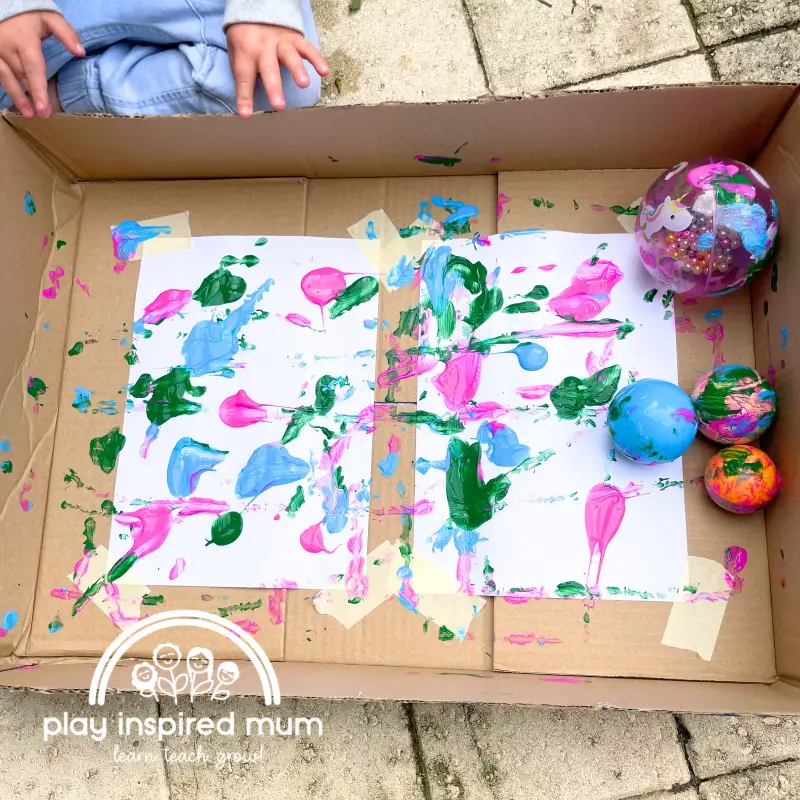
What is process art?
Process art is an approach to creating art that emphasizes the creative journey rather than focusing solely on the final product.
It encourages open-ended exploration, self-expression, and experimentation with materials, techniques, and ideas.
Process art celebrates the uniqueness of each artist and values the process of making art as an opportunity for personal growth and development.
It encourages creativity, problem-solving, sensory experiences, and individuality, providing a platform for artists to authentically express themselves and engage in the joy of creating without the pressure of predetermined outcomes.
What defines a STEAM activity?
A STEAM activity is an educational approach that combines Science, Technology, Engineering, Arts, and Mathematics to create a holistic learning experience.
It integrates these disciplines to foster critical thinking, problem-solving, creativity, and collaboration.
STEAM activities are hands-on and experiential, encouraging students to inquire, explore, and apply knowledge from multiple fields.
They promote innovation, real-world connections, and the development of essential skills for the 21st century.
Collaboration, communication, and reflection are key components of STEAM activities, empowering learners to become well-rounded, adaptable individuals prepared for future challenges.
STEAM elements of Ball painting with toddlers
When it comes to ball painting, there are several STEAM elements that can be associated with this engaging activity:
Science
Ball painting offers opportunities for children to explore scientific concepts, particularly when it comes to colour mixing.
By using different colored paints and rolling the balls across the surface, toddlers can observe how colours blend and create new shades.
This hands-on experimentation allows them to understand basic principles of color theory and the science behind color interactions.
Technology
Although technology may not be directly involved in ball painting, the use of various types of balls introduces different techniques and effects.
For instance, using bouncy balls can create a unique bouncing pattern on the canvas, while textured balls can produce interesting textures and imprints.
The selection and manipulation of balls can be seen as a technological aspect of the activity.
Engineering
Ball painting can be viewed as an engineering activity as children experiment with different rolling techniques and explore how the movement of the balls affects the paint patterns.
They can vary the force, speed, and direction of rolling to create different designs and pathways.
This experimentation helps develop an understanding of cause-and-effect relationships and basic engineering principles.
Arts
Of course, art is at the heart of ball painting.
This activity allows toddlers to engage in creative expression, exploring their imagination and creating unique artworks through the use of balls.
The process of rolling the balls, the patterns they create, and the freedom to experiment with colours and textures all contribute to the artistic element of ball painting.
Mathematics
While it may not be immediately apparent, mathematics can be incorporated into ball painting.
Toddlers can count the number of rolls or explore patterns and symmetry in their artwork.
They can also sort and classify different types of balls based on size, colour, or texture.
These mathematical concepts can be woven into the exploration and playfulness of the activity.
By incorporating these STEAM elements into ball painting, toddlers can engage in a multifaceted learning experience that stimulates their creativity, curiosity, and understanding of the world around them.
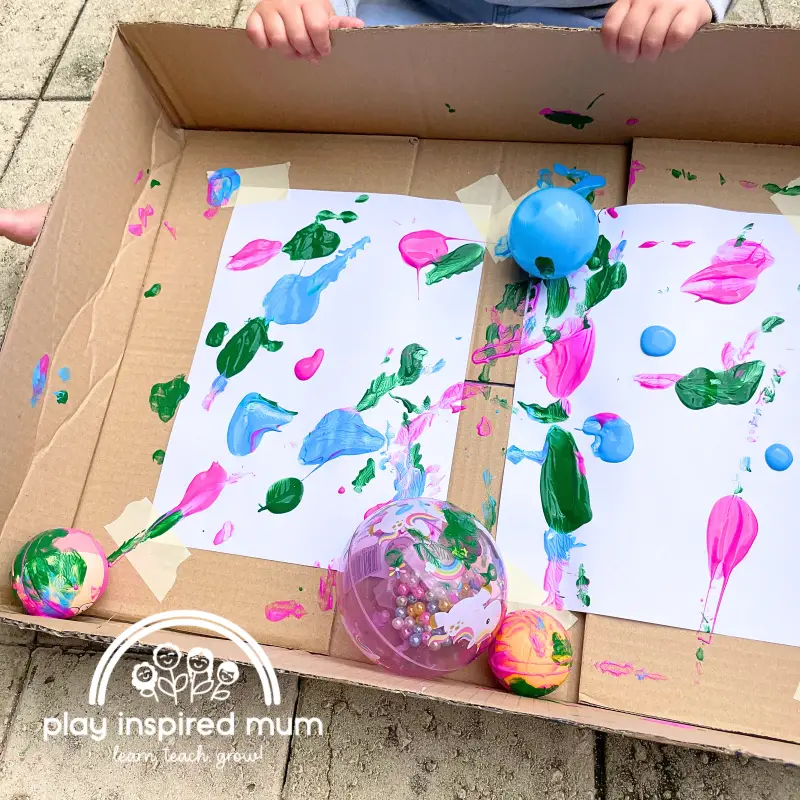
Incorporating STEAM Elements into Painting with Balls
When it comes to early childhood development, we absolutely need to engage those adorable toddlers in activities that spark their creativity, curiosity, and brainpower!
That’s where process art and STEAM (Science, Technology, Engineering, Arts, and Mathematics) activities come to the rescue!
Science:
Exploring color mixing and cause-effect relationships
Technology:
Using different types of balls for various painting effects
Engineering:
Experimenting with different ball-rolling techniques
Arts:
Encouraging self-expression and creativity through painting
Mathematics:
Counting and sorting the balls used in the activity
Why is it important to incorporate STEAM activities in early childhood education
Incorporating STEAM activities in early childhood education is important because it promotes
- holistic development
- critical thinking
- hands-on learning
- creativity
- real-world connections
- collaboration
- communication
These activities provide a well-rounded learning experience, fostering skills and abilities that are essential for future success.
By engaging children in STEAM disciplines from an early age, educators prepare them to navigate a rapidly changing world and develop a lifelong love for learning and innovation.
Why is ball painting good for toddlers?
Ball painting is a beneficial activity for toddlers as it encourages their creativity, fine motor skill development, sensory exploration, and cognitive growth.
Through rolling balls dipped in paint, toddlers can freely express themselves, experiment with colors and textures, and enhance their hand-eye coordination.
This engaging process allows them to explore cause-and-effect relationships, observe scientific concepts like colour mixing, and develop their artistic abilities.
Most of all, ball painting provides a fun and enjoyable experience for toddlers to engage with art, foster their imagination, and build a foundation for future learning and self-expression.
What to do with the painting once dry
Painting with balls results in plenty of creative, coloured masterpieces.
We used our ball paintings as gift wrap for a special friends birthday gift. We simply taped the pages together to create a larger piece and then wrapped per normal.
Here are some other ways of using the paintings:
- Display and Decorate: Find a prominent spot in your home or your child’s room to display their artwork. You can frame the paintings or use colorful clips to hang them in a designated art display area. This showcases your child’s creativity and allows them to take pride in their work.
- Rotate Artwork: If you have multiple paintings, consider rotating them on display. This allows your child to see their artwork in different contexts and keeps the display area fresh and exciting.
- Create a Gallery: Set up a mini art gallery at home where you can exhibit your child’s artwork. Use strings or ribbons to hang the paintings and invite family members or friends to admire the gallery during special occasions or playdates.
- Gift to Loved Ones: Consider giving the paintings as thoughtful gifts to grandparents, relatives, or close friends. They will appreciate the personal touch and be delighted to receive a unique piece of art made by your child.
- Art Scrapbook: Create an art scrapbook to preserve and showcase your child’s artistic journey. Include photographs of them engaged in the painting process and the final paintings. This becomes a cherished keepsake that you and your child can revisit and reminisce about their artistic endeavors.
- Collaborative Art Projects: Use the paintings as a starting point for collaborative art projects. Cut out shapes or sections from different paintings and create collages, or use them as backgrounds for additional artwork, such as drawings or cut-out paper shapes. Create bunting, gift cards, or small-world play settings.
Remember to celebrate and appreciate your child’s creativity and effort. By finding ways to honor and showcase their artwork, you encourage their passion for art and boost their self-confidence as budding artists.
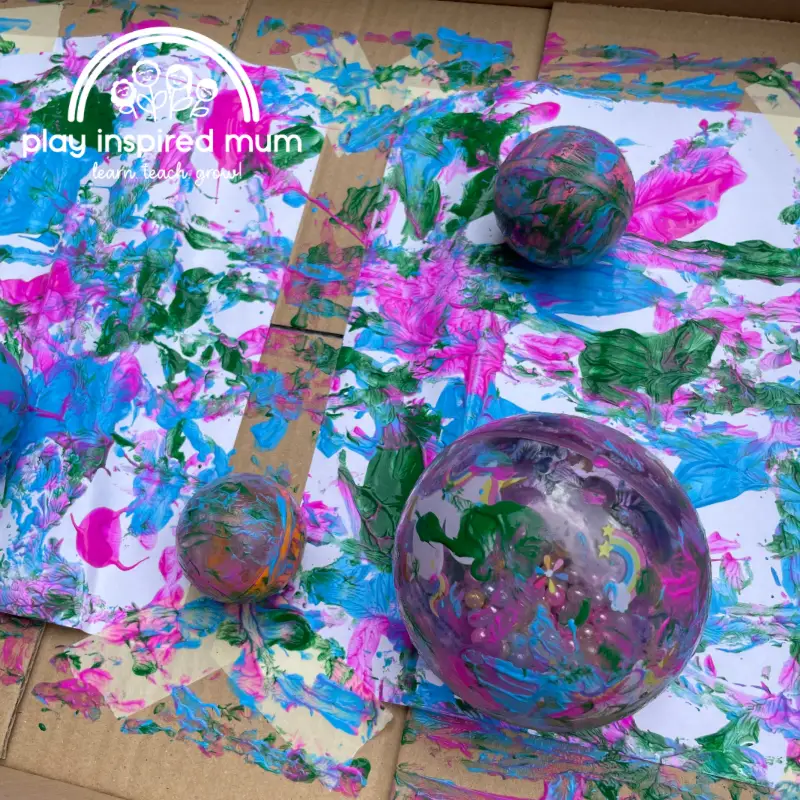
Toddler Painting with Balls
Through this process art activity, children not only create beautiful artworks but also enhance their cognitive, physical, emotional, and social development.
Painting with balls opens up a world of imagination, creativity, and exploration for toddlers, empowering them to express themselves freely and develop essential skills that will benefit them in various aspects of their lives.
So, let the joy of painting with balls inspire your child’s artistic journey and foster their growth and development along the way.

